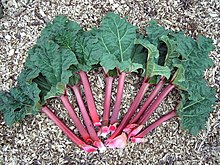
Back Rabarber Afrikaans Gemeiner Rhabarber ALS راوند الحدائق Arabic راوند الحدائق ARZ Rheum rhabarbarum AST Ravənd Azerbaijani Вълнообразен ревен Bulgarian Rheum rhabarbarum Catalan Rheum rhabarbarum CEB Reveň kadeřavá Czech
| Rhubarb | |
|---|---|

| |
| Scientific classification | |
| Kingdom: | Plantae |
| Clade: | Tracheophytes |
| Clade: | Angiosperms |
| Clade: | Eudicots |
| Order: | Caryophyllales |
| Family: | Polygonaceae |
| Genus: | Rheum |
| Species: | R. × hybridum (?)
|
| Binomial name | |
| Rheum × hybridum (?) | |
Rhubarb is the fleshy, edible stalks (petioles) of species and hybrids (culinary rhubarb) of Rheum in the family Polygonaceae, which are cooked and used for food.[2] The plant is a herbaceous perennial that grows from short, thick rhizomes. Historically, different plants have been called "rhubarb" in English. The large, triangular leaves contain high levels of oxalic acid and anthrone glycosides, making them inedible. The small flowers are grouped in large compound leafy greenish-white to rose-red inflorescences.
The precise origin of culinary rhubarb is unknown. The species Rheum rhabarbarum (syn. R. undulatum) and R. rhaponticum were grown in Europe before the 18th century and used for medicinal purposes. By the early 18th century, these two species and a possible hybrid of unknown origin, R. × hybridum, were grown as vegetable crops in England and Scandinavia. They readily hybridize, and culinary rhubarb was developed by selecting open-pollinated seed, so its precise origin is almost impossible to determine.[3] In appearance, samples of culinary rhubarb vary on a continuum between R. rhaponticum and R. rhabarbarum. However, modern rhubarb cultivars are tetraploids with 2n = 44, in contrast to 2n = 22 for the wild species.[4]
Although rhubarb is a vegetable, it is often put to the same culinary uses as fruits.[5] The leaf stalks can be used raw, when they have a crisp texture (similar to celery, although it is in a different family), but are most commonly cooked with sugar and used in pies, crumbles and other desserts. They have a strong, tart taste. Many cultivars have been developed for human consumption, most of which are recognised as Rheum × hybridum by the Royal Horticultural Society.[6]
- ^ "Rheum × hybridum Murray". Plants of the World Online. Royal Botanic Gardens, Kew. Retrieved 10 March 2019.
- ^ Foust, Clifford M.; Marshall, Dale E. (1 November 1991). "Culinary Rhubarb Production in North America: History and Recent Statistics". HortScience. 26 (11): 1360–1363. doi:10.21273/hortsci.26.11.1360. ISSN 0018-5345.
- ^ Tanhuanpää, Pirjo; Suojala-Ahlfors, Terhi & Hartikainen, Merja (2019). "Genetic diversity of Finnish home garden rhubarbs (Rheum spp.) assessed by simple sequence repeat markers". Genetic Resources and Crop Evolution. 66 (1): 17–25. doi:10.1007/s10722-018-0692-8. S2CID 52821042.
- ^ Libert, Bo & Englund, Roger (1989). "Present Distribution and Ecology of Rheum rhaponticum (Polygonaceae)". Willdenowia. 19 (1): 91–98. JSTOR 3996925.
- ^ Hood, Karen Jean Matsko (1 January 2014). Rhubarb Delights Cookbook: A Collection of Rhubarb Recipes. Spokane Valley: Whispering Pine Press International. pp. 20, 22. ISBN 978-1-930948-00-6.
- ^ "RHS Plantfinder – Rhubarb". Retrieved 23 September 2018.
© MMXXIII Rich X Search. We shall prevail. All rights reserved. Rich X Search